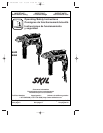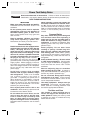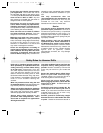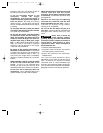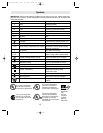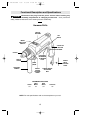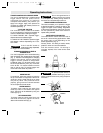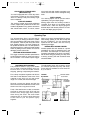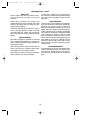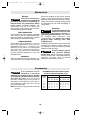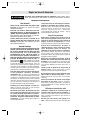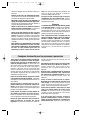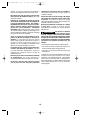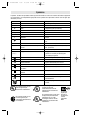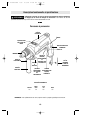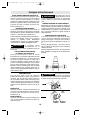
-3-
Safety Rules for Hammer Drills
Hold tool by insulated gripping surfaces
when performing an operation where the
cutting tools may contact hidden wiring
or its own cord. Contact with a “live” wire
will make exposed metal parts of the tool
“live” and shock the operator. Do not drill,
fasten or break into existing walls or other
blind areas where electrical wiring may exist.
If this situation is unavoidable, disconnect all
fuses or circuit breakers feeding this
worksite.
Wear ear protectors when using the tool
for extended periods. Prolonged exposure to
high intensity noise can cause hearing loss.
Always use auxiliary handle for maximum
control over torque reaction or kick-back.
High torque 3/8" and larger chuck capacity
drills are equipped with auxiliary handles.
Always wear safety goggles or eye
protection when using this tool. Use a
dust mask or respirator for applications
which generate dust.
Use thick cushioned gloves and limit the
exposure time by taking frequent rest
periods. Vibration caused by hammer-drill
action may be harmful to your hands and
arms.
Secure the material being drilled. Never
hold it in your hand or across legs.
Unstable support can cause the drill bit to
bind causing loss of control and injury.
Never leave the trigger locked "ON".
Before plugging the tool in, check that the
trigger lock is "OFF". Accidental start-ups
could cause injury.
Position the cord clear of rotating bit. Do
not wrap the cord around your arm or
wrist. If you lose control and have the cord
wrapped around your arm or wrist it may
entrap you and cause injury.
Position yourself to avoid being caught
between the tool or side handle and walls
or posts. Should the bit become bound or
Do not force tool. Use the correct tool for
your application. The correct tool will do
the job better and safer at the rate for which
it is designed.Do not use tool if switch
does not turn it “ON” or “OFF”. Any tool
that cannot be controlled with the switch is
dangerous and must be repaired.
Disconnect the plug from the power
source before making any adjustments,
changing accessories, or storing the tool.
Such preventive safety measures reduce the
risk of starting the tool accidentally.
Store idle tools out of reach of children
and other untrained persons. Tools are
dangerous in the hands of untrained users.
Maintain tools with care. Keep cutting
tools sharp and clean. Properly maintained
tools, with sharp cutting edges are less likely
to bind and are easier to control. Any
alteration or modification is a misuse and
may result in a dangerous condition.
Check for misalignment or binding of
moving parts, breakage of parts, and any
other condition that may affect the tools
operation. If damaged, have the tool
serviced before using. Many accidents are
caused by poorly maintained tools. Develop
a periodic maintenance schedule for your
tool.
Use only accessories that are
recommended by the manufacturer for
your model. Accessories that may be
suitable for one tool, may become
hazardous when used on another tool.
Service
Tool service must be performed only by
qualified repair personnel. Service or
maintenance performed by unqualified
personnel could result in a risk of injury. For
example: internal wires may be misplaced or
pinched, safety guard return springs may be
improperly mounted.
When servicing a tool, use only identical
replacement parts. Follow instructions in
the Maintenance section of this manual.
Use of unauthorized parts or failure to follow
Maintenance Instructions may create a risk
of electric shock or injury. Certain cleaning
agents such as gasoline, carbon
tetrachloride, ammonia, etc. may damage
plastic parts.
SM 2610993480 7/00 8/3/00 12:40 PM Page 3



